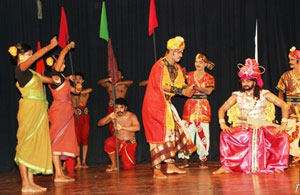Ashoka is a swirling kaleidoscope of music, dance and drama portrayed through the full-fledged medium of mime. The play, complete with an ornately costumed cast, projects the senseless devastation caused by war and spreads the message of unity, integrity, peace and harmony in society.
The adaptation presented by the Centre for Performing Arts (CPA) in association with the Mahatma Gandhi Centre at the Elphinstone Theatre recently, is a historical drama chronicling the odyssey of the warlord Emperor Asoka who ascended the throne of Magadha in the third century BC. Desperately wanting to extend the boundaries of his kingdom he declared war on a neighbouring province killing and maiming thousands in the process. Eventually overcome with remorse, he renounced violence and dedicated his life to spreading the word of Buddhism across the world.
The CPA’s Director Rev. Fr. Prof. N. M. Saveri first devised and directed the play in 1993 combining sign language with drama, dance, music and ritual to create a visually exciting form of theatre. Of the performance, one thing is sure, it is devoid of monotony. In all, it is tempestuous, fast-moving and vibrantly colourful with the concept of continuity flowing in breathtaking cohesion.
The director/choreographer’s meticulous discipline and aptitude were demonstrated conspicuously not only in the brilliant reflections of the dancers’ rhythmic grace but in the sound consistency for splendid entertainment. Yet despite the presence of rage, repression and ruin which tend to predominate, the storyline is kept on an even keel.
That is evidently because it is clearly balanced between the metaphors of joy and pathos which are cleverly interspersed to enhance its vividly striking presentation.
The encounters of war are staged with bold action-packed assurance complemented largely by the cadence of the measured roll of marching kettledrums. The floorboards are hardly left unstomped during the battle scenes where the armies engage in mortal combat. The whirling and twirling of fancy footwork combined with dexterous swordplay intensify the awesome enactment of swashbuckling warriors as they rhythmically parody the flamboyant martial arts of the period.
There were so many captivatingly emotional moments interlaced with brilliant dramatization and projected with more than the usual humane characterisation that makes a powerful presence on the audience. The supporting cast too had all been remarkably programmed to interknit adeptly on cue enhancing the illusion of a far larger ensemble than its actual troupe of players.
The special effects of flashing strobe-lighting and superb musical phrasing reach a crashing crescendo with orchestration comprising sitar, violin and percussion complemented by haunting vocalization to evoke a stirring appeal to lift even the most melancholy senses. While the pace is swift and even, the story unfolds in a solidly accessible style, where Asoka the decisive ruler and mighty conqueror is finally transformed into a messenger of peace. From the darkening vision of power, war, victory and tragic loss he is uplifted to a plane of spiritual enlightenment.
The play is a historic reminder of the futility of war and that even the most militant monarchs of yore displayed a sagacious awareness to fall back on an old strategy that has often proved to rake in rich dividends. Conquerors such as Asoka were able to expound the logical theory that it would be wiser to bring a convert into their tents than make an unnecessary enemy. With that turning point in world history enacted aeons ago one would expect a display of similar statesmanship from today’s world’s leaders to avoid confrontation at any cost.
It is also takes a leaf from a rare chapter in history that offers an object lesson that in the aftermath of war, reconstruction and rehabilitation will have to go hand-in-hand with fresh efforts towards reconciliation. It is classical eastern ballet aimed at unravelling a story of loss, grief, death and redemption without the use of voice or spoken word. The CPA has always been in the vanguard in its quest for a durable peace. In its mission for real reform it has largely through the performing arts, cultural exchanges and various forums achieved a great deal in tightening the nuts and bolts of integration.
Fr. Prof. Saveri as original playwright /director has enhanced his remarkable record of creativity as a skilful communicator and peace advocate with this brilliant expression of theatre. The play is woven innovatively with a beguiling blend of charm, simplicity and timelessness that dovetails smoothly into a timeless context which embraces the breadth of universal humanity.
But what is most significant about Ashoka is that it is not solely as entertainment or theatre that it evokes appreciation and the admiration of its audiences. It is a dexterous combination of musical entertainment and drama that transcends religious, racial and generational barriers. It could best be described as a dramatic dialogue being expressed entirely with the poetic articulation of body language and the eyes.
More importantly and particularly in a local context the art form has helped propel the thespian soul to overstep the shackles of language and effectively communicate a wordless world of hope and sensitivity to audiences of all ethnic communities.
Working against an inspiring historical backdrop Ashoka evokes a world of courage that mocks all warmongers and confrontational regimes. It leaves behind a remarkable legacy, a legacy of courage, compassion and charity. It is all described at a cracking good pace.
Tyrants of the world, take note! |


